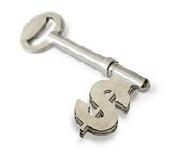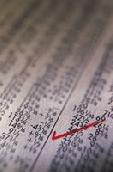
 |
|
| Financial Terms | |
| PIN (personal identification number) |
|
Information about financial, finance, business, accounting, payroll, inventory, investment, money, inventory control, stock trading, financial advisor, tax advisor, credit.
Main Page: stock trading, payroll, inventory, accounting, financial advisor, credit, tax advisor, inventory control, |
Definition of PIN (personal identification number)
PIN (personal identification number)A secret code that you use to access your bank account at a bank machine or at a point of sale (POS) terminal. You may also have a pin for banking by telephone.
Related Terms:BootstrappingA process of creating a theoretical spot rate curve , using one yield projection as the basis for Clean opinionAn auditor's opinion reflecting an unqualified acceptance of a company's financial statements. Disclaimer of opinionAn auditor's statement disclaiming any opinion regarding the company's financial Except for opinionAn auditor's opinion reflecting the fact that the auditor was unable to audit certain areas Law of large numbersThe mean of a random sample approaches the mean (expected value) of the Opinion shoppingA practice prohibited by the SEC which involves attempts by a corporation to obtain Personal tax view (of capital structure)The argument that the difference in personal tax rates between  Personal trustAn interest in an asset held by a trustee for the benefit of another person. ShoppingSeeking to obtain the best bid or offer available by calling a number of dealers and/or brokers. Spin-offA company can create an independent company from an existing part of the company by selling or Stopping curveA curve showing the refunding rates for different points in time at which the expected value Stopping curve refunding rateA refunding rate that falls on the stopping curve. Subject to opinionAn auditor's opinion reflecting acceptance of a company's financial statements subject to NUMBER OF DAYS SALES IN RECEIVABLES(also called average collection period). The number of days of net sales that are tied up in credit sales (accounts receivable) that haven’t been collected yet. Specific identificationA method of accounting for inventory. dumpingselling products abroad at lower prices than those  Bootstrapping, bootstrap methodAn arithmetic method for backing an Federal Employer Identification NumberA unique identification number issued Personal Responsibility and Work Opportunity Reconciliation ActA federal Act requiring the reporting of new hires into a national database. Financial Numbers GameThe use of creative accounting practices to alter a financial statement Free-on-Board (FOB) Shipping PointA shipping arrangement agreed to between buyer and LIFO DippingReducing LIFO inventory quantities and, as a result, including older and lower Item numberA number uniquely identifying a product or component. Nonsignificant part numberAn identifying number assigned to a part that conveys Part numberA number uniquely identifying a product or component. Significant part numberAn identifying number assigned to an item that conveys Personal AssetsAssets, the title of which are held personally rather than in the name of some other legal entity.  Personal GuaranteeA legal document whereby an individual takes responsibility for payment of debt or performance of some obligation if the person/company primarily liable fails to perform. Personal Overdraft FacilityA loan facility on a customers account at a financial institution allowing the customer to overdraw up to a certain agreed limit for an agreed period. personal loanA lump sum that you borrow from a financial institution for a specified period of time. To repay the loan, you pay interest on the entire lump sum, and make payments on a scheduled basis. personal line of credit (PLC)A revolving source of credit with a pre-established limit. You access the funds only as you need them, and any amount that you pay back becomes accessible to you again. Unlike a personal loan, a PLC permits you to write cheques and make bank machine withdrawals, and requires you to pay interest only on the funds that you actually use. Personal Line of credit (Credit Insurance)A bank's commitment to make loans to a borrower up to a specified maximum during a specific period, usually one year. Interac® Direct PaymentInstead of paying with cash or a credit card, Interac Direct Payment allows you to pay for your purchase with a debit card, such as your bank card. The amount of the purchase is electronically debited, or withdrawn, from your bank account (see debit card). Related to : financial, finance, business, accounting, payroll, inventory, investment, money, inventory control, stock trading, financial advisor, tax advisor, credit. |